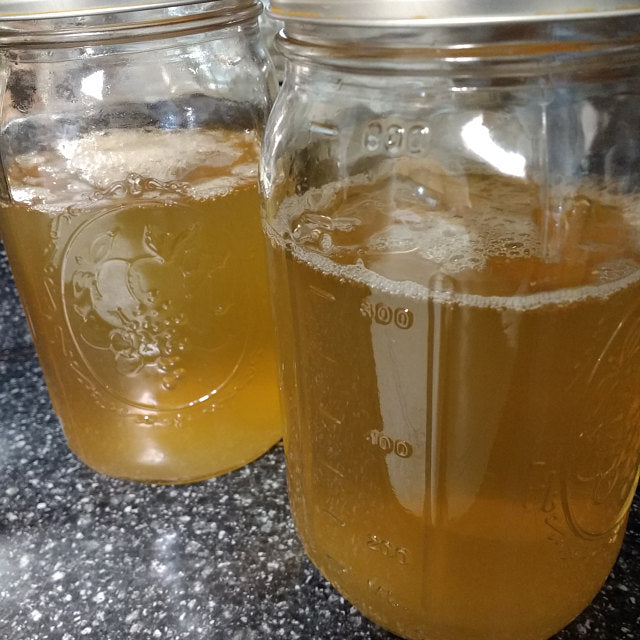
When it comes to water kefir or ginger beer, most people prefer it fizzy. It adds dimension, taste and fun to a healthy beverage. For those who just have to have that fizz, here’s our guide to getting the most fizz out of your fermented beverage:
Everyone talks about 2nd ferments when it comes to carbonation, but the real key to getting good carbonation is a strong first ferment. If your first ferment is weak, you will likely have trouble getting significant fizz no matter what you do during the 2nd ferment. If its still really sweet after 48 hours, you will have a hard time getting that delicious multidimensional flavor or much carbonation during the 2nd ferment or storage. Carbonation tends to kick into gear only when the yeast is strong and the sugar content is low.
- Minerals in the sugar, Minerals in the water.
Yeast is what creates the carbonation. The stronger the yeast, the stronger the fizz. Yeast loves minerals, so make sure to do a mineral rich ferment with at-least 50% of a dark mineral sugar. Try a spoonful of molasses to really get that yeast happy. Also, minerals in the water is just as important. Mineral or well water is best. If you have to use filtered water or your water is really soft, then add some trace mineral drops or calcium supplements. Boiled egg shells, baking soda, dolomite are good choices.
- Heat

Yeast loves the heat and helps create stronger yeast. Try for the low to mid 70’s for a strong balanced ferment. If its below 70, it can still ferment fine, but it tends to be bacteria rich and sour instead of tangy and fizzy.
1. 2nd Ferment
Now that you have a strong first ferment that’s not very sweet anymore and somewhat tangy, its ready for a 2nd ferment. It may be already slightly fizzy or have very little fizz, either way is okay.
Here are some things you can add during the 2nd ferment (when the grains are out) to really get that carbonation going during:
-
Fruit Juice: Fruit juices are probably the easiest way to get carbonation. Be aware that fruit juices can also create higher levels of alcohol. I recommend grape juice, its delicious and can create a bombs worth amount of carbonation. Apple, pomegranate, cherry, prune juice are also good options. Add a couple ounces and let sit for 1-2 days at room temperature with a lid on. Keep an eye on it though as the carbonation does have the potential to break the jar. Burp the jar or bottle if need be. Chill in the fridge before drinking.
-
Fresh ginger: The yeast will thank you. You can use the juice but blending the ginger with some water and then strain the juice from all the fiber. Another option is to peel the ginger and cut up discs of ginger which you can easily remove before consuming.
-
Organic Lemon, lime or orange peel: Citrus peels can make it fizzy and delicious. Be sure to take them out after a few hours so it doesn’t become bitter though.
- Add a teaspoon or so of fresh sugar: Any sugar can work, but darker sugars tend to work a little better.
3. Swing top bottles
Swing top bottles are a must for those serious about bottling and carbonation. It’s ideal for building carbonation and durable enough to withstand extreme carbonation (although be aware that they can still break). I recommend leaving about a 2 inch head space when bottling the kefir.
5. Airlock or closed lid first ferment
Water kefir can ferment anaerobic (without oxygen) if desired. Traditionally, water kefir was fermented with an open lid, but they can do just as well with a closed lid or airlock system. If you want carbonation / fizz and want to drink it fresh without a 2nd ferment, then this is the best option. If you plan to do a 2nd ferment or a few days of storage in the fridge, then it doesn't really matter that much if you use a open or closed lid.
4. Ginger beer plant
Try the ginger beer plant instead of water kefir grains. Ginger beer tends to be naturally fizzier than water kefir due to the yeast composition, higher mineral needs and longer ferments.
5. Fridge storage
Skip the 2nd ferment and simply store in the fridge. Some of my strongest fizzy ferments are ferments that are simply stored in a closed lid in the fridge for a few days without a 2nd ferment. If you had a strong ferment with plenty of yeast activity, a few days in the fridge will build a significant amount of carbonation without the need to add anything else.
Note: You can combine 2nd ferments and a long fridge storage for even more carbonation.
6. Water Kefir Recipes
Search our favorite water kefir recipes that are balanced for flavor as well as fizz. Most will create an abundant amount of carbonation to satisfy your all fizzy needs.
Summary: Start with a strong first ferment which includes a mineral / nutrient rich recipe as well as mineral rich water. Ferment for 48 hours in the 70-75 degree range. Do a 2nd ferment with a bit of fruit juice or ginger or citric peels or fresh sugar (or a combination). Let sit for 1-2 days. Chill in the fridge and enjoy.





Comments
Katie
If I do a second ferment, is it absolutely necessary to use a closed bottle? I know it won’t be fizzy if I use an open container for the second ferment, I’m just wondering if anything bad would happen. The swing top bottles are annoying to clean and I’d rather just use a jar for both ferments, unless I’m setting myself up to get sick or something…
March 17, 2019
Alex Parker
Odette, you can have grains that produce decent kefir, but not multiple. At some point if they don’t grow, you will likely need to replace them. Sometimes a good rinse or rest in the fridge can help kick start them into growth again.
December 18, 2018
Odette
I bought kefir grains from Amazon but they remain very small,like wet sugar and they do not multiply.I use dark sugar and molasses and it still does not work.I’m on my 5th badch.Does that mean my grains are no good
December 16, 2018
David
Thanks for the information. I tried some grape juice and boy did I get plenty of carbonation and fizz. It was slightly more alcohol then I wanted, but I think it was because I left it long. Still delicious though.
October 12, 2018
Leave a comment